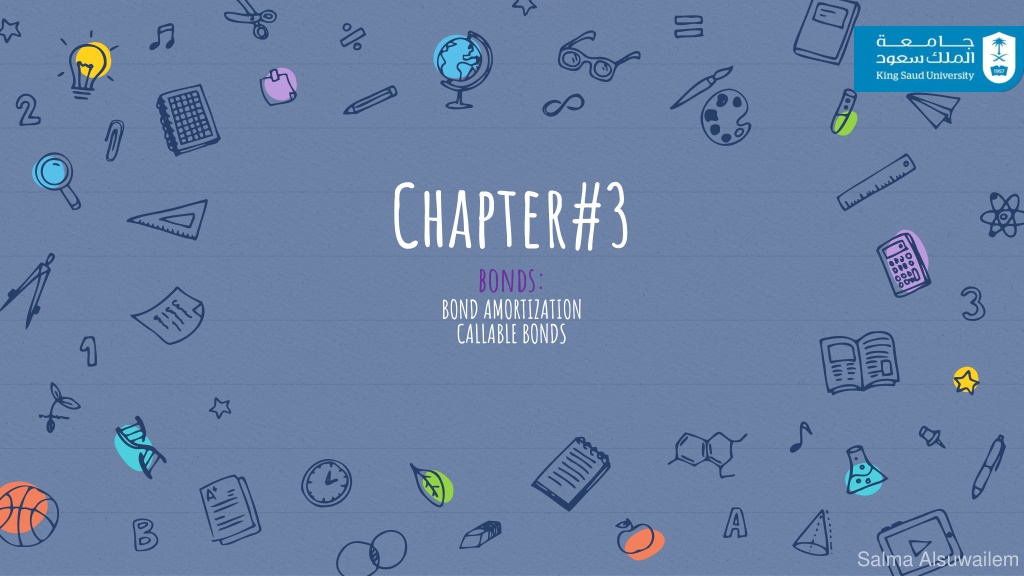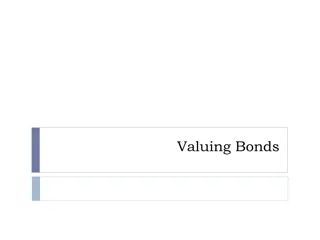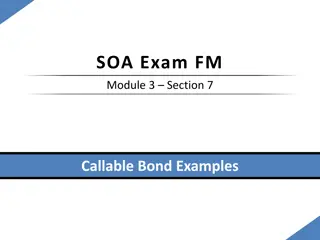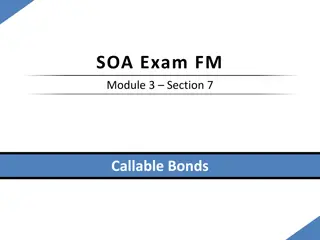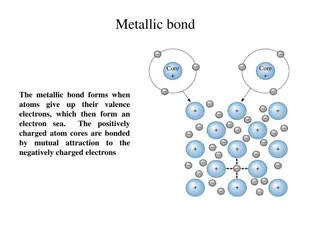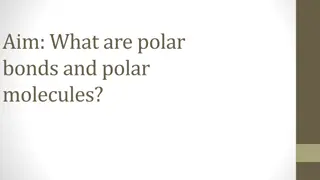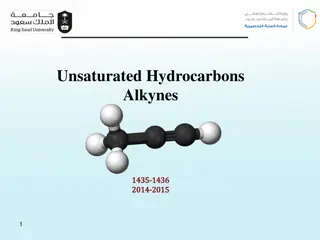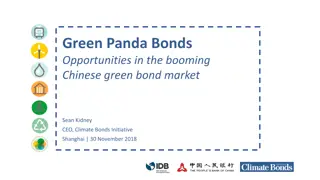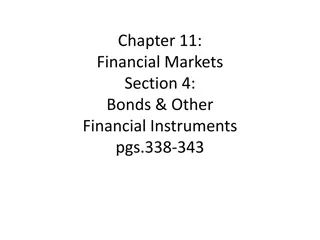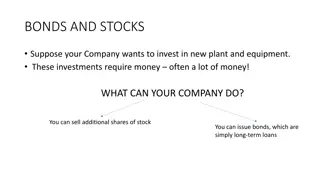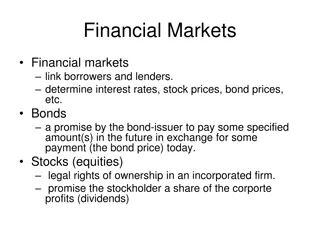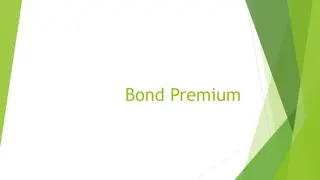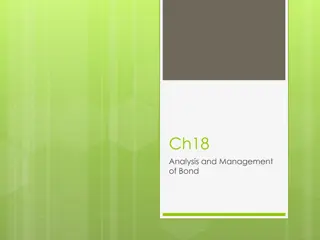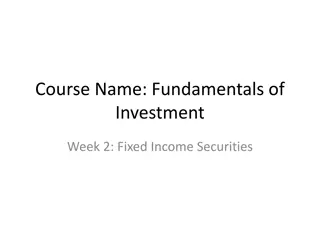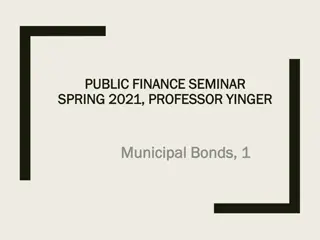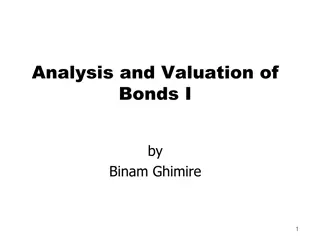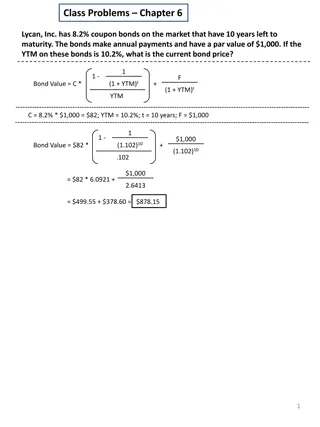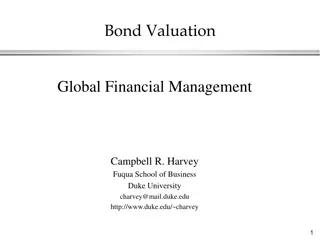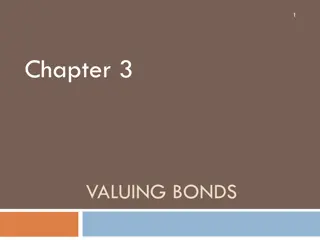Understanding Callable Bonds and Bond Amortization
Callable bonds provide issuers with the right to redeem the bond before maturity under certain conditions. This article discusses the concept of callable bonds, bond amortization, premium bonds, discount bonds, and provides examples of calculating bond values based on specific scenarios.
Download Presentation

Please find below an Image/Link to download the presentation.
The content on the website is provided AS IS for your information and personal use only. It may not be sold, licensed, or shared on other websites without obtaining consent from the author. Download presentation by click this link. If you encounter any issues during the download, it is possible that the publisher has removed the file from their server.
E N D
Presentation Transcript
Chapter#3 bonds: BOND AMORTIZATION CALLABLE BONDS Salma Alsuwailem
Book Value: The time-t book value is the time-t PV of the remaining cash flows discounted at the original yield rate: Bt=Fr ?? ?|+C?n-t= P(1+i)t-Fr ? ?|. Note: B0=P , Bn=C Interest Earned: The interest earned during period t is the time t 1 book value multiplied by the yield rate: It=i.Bt-1 Bond Amortization (principal repaid): Amortized amount of premium in period t : (Fr-Ci).vn-t+1 = Bt-1- Bt The amount for accumulation of discount in period t: (Ci-Fr).vn-t+1 = Bt- Bt-1 2 Salma Alsuwailem
Premium Bond Discount Bond Condition P>C P<C Amortization of Premium Accumulation of Discount Amount Amortization Process Write-Down Write-Up 3 Salma Alsuwailem
What is a callable bond? A callable bond is a bond which gives the issuer (not the investor) the right to redeem prior to its maturity date, under certain conditions. When issued, the call provisions explain when the bond can be redeemed and what the price will be. In most cases, there is some period of time during which the bond cannot be called. This period of time is named the call protection period. The earliest time to call the bond is named the call date. The call price is the amount of money the insurer must pay to buy the bond back. Assuming that the redemption value is a constant and that a bond can be called after any coupon payment: (i) if Fr > Ci (bond sells at a premium), ?tincreases with t, and we assume the redemption date is the earliest possible. (ii) if Fr < Ci (bond sells at a discount), ?tdecreases with t, and we assume that the redemption date is the latest possible. 4 Salma Alsuwailem
examples Matt purchased a 20-year par value bond with an annual nominal coupon rate of 8% payable semiannually at a price of 1722.25. The bond can be called at par value X on any coupon date starting at the end of year 15 after the coupon is paid. The lowest yield rate that Matt can possibly receive is a nominal annual interest rate of 6% convertible semiannually. Calculate X. (A) 1400 (B) 1420 (C) 1440 (D) 1460 (E) 1480 5 Salma Alsuwailem
Toby purchased a 20-year par value bond with semiannual coupons of 40 and a redemption value of 1100. The bond can be called at 1200 on any coupon date prior to maturity, starting at the end of year 15. Calculate the maximum price of the bond to guarantee that Toby will earn an annual nominal interest rate of at least 6% convertible semiannually. (A) 1251 (B) 1262 (C) 1278 (D) 1286 (E) 1295 6 Salma Alsuwailem
Mary purchased a 10-year par value bond with an annual nominal coupon rate of 4% payable semiannually at a price of 1021.50. The bond can be called at 100 over the par value of 1100 on any coupon date starting at the end of year 5 and ending six months prior to maturity. Calculate the minimum yield that Mary could receive, expressed as an annual nominal rate of interest convertible semiannually. (A) 4.7% (B) 4.9% (C) 5.1% (D) 5.3% (E) 5.5% 7 Salma Alsuwailem
A 40-year bond is purchased at a discount. The bond pays annual coupons. The amount for accumulation of discount in the 15th coupon is 194.82. The amount for accumulation of discount in the 20th coupon is 306.69. Calculate the amount of discount in the purchase price of this bond. (A) 13,635 (B) 13,834 (C) 16,098 (D) 19,301 (E) 21,135 8 Salma Alsuwailem
An investor owns a bond that is redeemable for 300 in seven years. The investor has just received a coupon of 22.50 and each subsequent semiannual coupon will be X more than the preceding coupon. The present value of this bond immediately after the payment of the coupon is 1050.50 assuming an annual nominal yield rate of 6% convertible semiannually. Calculate X. (A) 7.54 (B) 10.04 (C) 22.37 (D) 34.49 (E) 43.98 9 Salma Alsuwailem
Jeff has 8000 and would like to purchase a 10,000 bond. In doing so, Jeff takes out a 10 year loan of 2000 from a bank and will make interest-only payments at the end of each month at a nominal rate of 8.0% convertible monthly. He immediately pays 10,000 for a 10-year bond with a par value of 10,000 and 9.0% coupons paid monthly. Calculate the annual effective yield rate that Jeff will realize on his 8000 over the 10-year period. (A) 9.30% (B) 9.65% (C) 10.00% (D) 10.35% (E) 10.70% 10 Salma Alsuwailem
A 1000-par value 30-year bond has an annual coupon rate of 7% paid semiannually. After an initial 10-year period of call protection, the bond is callable immediately following the payment of any of the 20th through the 59th coupons. i) If the bond is called before payment of the 40th coupon, the redemption value is 1250. ii) If the bond is called immediately after the payment of any of the 40th through the 59th coupons, the redemption value is 1125. iii) If the bond is not called, it will be redeemed at par. To ensure that the bond will provide at least an annual nominal yield rate of 5% convertible semiannually, it must be assumed that the bond will be called or redeemed immediately after the payment of the nth coupon. Calculate n. (A) 20 (B) 39 (C) 40 (D) 59 (E) 60 11 Salma Alsuwailem
THANKS! Any questions? 12 Salma Alsuwailem
